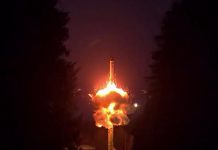The religious violence which has vexed Delhi since the weekend is the deadliest in decades. What began as small clashes between supporters and opponents of a controversial citizenship law quickly escalated into full-blown religious riots between Hindus and Muslims, in congested working-class neighborhoods on the fringes of the sprawling capital.
Taliban Reject Western Style Democracy; Calls For Islamic Laws in Afghanistan
Four days and 30+ deaths later, Prime Minister Narendra Modi tweeted his first appeal for peace. Many pointed to the egregious failure of Delhi’s police – the most well-resourced in India – and the inability of opposition parties to rally together hit the streets and calm tensions. In the end, the rioters operated with impunity, and the victims were left to their fate.
Not surprisingly, the ethnic violence in Delhi has drawn comparisons with two of India’s worst sectarian riots in living memory. Nearly 3,000 people were killed in anti-Sikh riots in the capital in 1984 after the then prime minister Indira Gandhi was assassinated by her Sikh bodyguards.
And in 2002, more than 1,000 people, mostly Muslims, died after a train fire killed 60 Hindu pilgrims in Gujarat – Mr. Modi was then the chief minister of the state. The police were accused of complicity in both riots. The Delhi High Court, which is hearing petitions about the current violence, has said it cannot let “another 1984” happen on its “watch”.
The similarities between 1984 where hundreds of Sikhs were killed over just three days of violence that engulfed all of Delhi; and 2002 when hundreds were massacred in heinous violence all over Gujarat and now 2020 are striking. As the modus operandi is similar, and the images strikingly familiar.
1. The spread of rumors:
Rumors spread like wildfire before the violence that was justified through versions of events that swept through the people without verification. It was Sikhs distributing sweets after Indira Gandhi’s assassination in Delhi; it was the Godhra train fires in Gujarat, and it was protests against the Citizenship Amendment Act in Delhi.
2. Hate speeches:
More so in 2002 and now in the run-up the Assembly polls and this bout of violence in Delhi as amplified over the social media. In 1984 there was no television; in 2002 no social media; in 2020 citizens have the benefit of all and more for the vitriol to spread at an alarming speed.
3. Armed mobs:
This is the first time that guns have appeared, but lathis, iron rods, stones, swords, daggers have been in use. Arson has been resorted to in all the three big incidents of violence with transport, shops, residences being gutted. In 1984 it was bonfires with bodies being burnt inside by mobs, a series of bonfires.
In 2002 Muslims were trapped in fires, and their properties gutted. In 2020 arson has been used all across the localities with latest reports of children trapped inside a burning madrassa adding fresh horror to the current trajectory of violence.
4. Specific targeting of the ‘other’:
In 1984 where the violence had spread through Lutyens Delhi and South Delhi as well, the mobs had lists of addresses where the Sikhs lived. And a list of Sikh owned properties even in markets like Connaught place where their hotels and shops were set on fire.
The same pattern of information was visible in both Gujarat and now in the Delhi violence, where the Muslim homes and properties are being singled out for attack while adjacent shops belonging to non-Muslims are left unscathed.
5. Non-existent opposition:
In 1984 the Congress leaders led the mobs supported by RSS cadres, as has been documented. In 2002, the BJP/RSS cadres led the attacks while the Congress party slumbered. And in fact, even later was unable to pick up the pieces with party president Sonia Gandhi refusing to visit the widow of party leader Ehsan Jafri who had been brutally killed by mobs.
In 2020, the Delhi government under Arvind Kejriwal has been unable to take a stand, holding a cabinet meeting only after two days of uninterrupted violence. He is finding it difficult to even ask the central government to deploy the Army in the impacted areas. The Congress party, of course, is only tweeting.
6. The administration has disappeared as has the police:
In 1984, the police just vanished. In 2002 it was visible protecting the mobs in Gujarat and not the victims. In 2020 the Delhi police are either absent or with the armed mobs. It has been unable to restore order in a single instance.
The only difference is the level of awareness because of the social media which of course reflects the intense polarization, or perhaps even more so, of the streets. Despite the almost minute by minute updates, the response pattern of the authorities is the same as it was in 1984.
In 2002 the government never really did react. In 2020 the government has held a meeting convened by Union Home Minister Amit Shah but the violence continues. Tragic really that despite two big landmarks of violence from the past, and hundreds of others dotting the Indian landscape, the political response remains one of complicity or total indifference.




